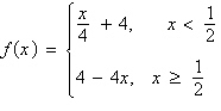A) ![]()
B) ![]()
C) ![]()
D) ![]()
E) ![]()
Correct Answer

verified
Correct Answer
verified
Multiple Choice
Which graph represents the function? 
A) ![]()
B) ![]()
C) ![]()
D) ![]()
E) ![]()
Correct Answer

verified
E
Correct Answer
verified
Multiple Choice
Which set of ordered pairs represents a function from P to Q? 

A) ![]()
B) ![]()
C) ![]()
D) ![]()
E) ![]()
Correct Answer

verified
Correct Answer
verified
Multiple Choice
Does the table describe a function? 
A) no
B) yes
Correct Answer

verified
Correct Answer
verified
Multiple Choice
Write the slope-intercept form of the equation of the line through the given point perpendicular to the given line. point: (-7, -8) line: -9x - 45y = 9
A) ![]()
B) ![]()
C) ![]()
D) ![]()
E) ![]()
Correct Answer

verified
Correct Answer
verified
Multiple Choice
Use a graphing utility to graph the function and find the zeroes of the function. 
A) ![]()
B) ![]()
C) ![]()
D) no real zeroes
E) ![]()
Correct Answer

verified
Correct Answer
verified
Multiple Choice
Describe the sequence of transformations from the related common function  to g.
to g. 
A) vertical shift 4 units up; then vertical shrink by a factor of 4
B) horizontal shift 4 units left; then vertical shrink by a factor of 4
C) horizontal shift 4 units right; then vertical stretch by a factor of 4
D) vertical shift 4 units down; then vertical shrink by a factor of 4
E) horizontal shift 4 units left; then vertical stretch by a factor of 4
Correct Answer

verified
Correct Answer
verified
Multiple Choice
Find  .
. 

A) ![]()
B) ![]()
C) ![]()
D) ![]()
E) ![]()
Correct Answer

verified
E
Correct Answer
verified
Multiple Choice
Use the Vertical Line Test to determine in which of the graphs y is not a function of x.
A) All of the choices (A, B, C, and D) represent functions.
B) ![]()
C) ![]()
D) ![]()
E) ![]()
Correct Answer

verified
Correct Answer
verified
Multiple Choice
Evaluate the indicated function for  and
and  . ( fg ) (1)
. ( fg ) (1)
A) 12
B) -32
C) -20
D) -16
E) -30
Correct Answer

verified
Correct Answer
verified
Multiple Choice
Which function does the graph represent? 
A) g(x) = ![]()
![]()
![]()
B) ![]()
C) g(x) = ![]()
![]()
![]()
![]()
D) g(x) = ![]()
![]()
![]()
E) g(x) = ![]()
![]()
![]()
Correct Answer

verified
Correct Answer
verified
Multiple Choice
Determine whether the function is even, odd, or neither. 
A) neither
B) even
C) odd
Correct Answer

verified
Correct Answer
verified
Multiple Choice
Does the table describe a function? 
A) yes
B) no
Correct Answer

verified
Correct Answer
verified
Multiple Choice
Which equation does not represent y as a function of x?
A) ![]()
B) ![]()
C) ![]()
D) ![]()
E) ![]()
Correct Answer

verified
Correct Answer
verified
Multiple Choice
Write an equation for the function that is described by the following characteristics: the shape of  , but moved eight units down, two units to the left, and then reflected in the x-axis
, but moved eight units down, two units to the left, and then reflected in the x-axis
A) ![]()
B) ![]()
C) ![]()
D) ![]()
E) ![]()
Correct Answer

verified
Correct Answer
verified
Multiple Choice
Evaluate the function at the specified value of the independent variable and simplify. 

A) 3.8
B) ![]()
C) ![]()
D) ![]()
E) -6.2
Correct Answer

verified
Correct Answer
verified
Essay
Show algebraically that f and g are inverse functions.



Correct Answer

verified
11eb11e8_19d2_00bf_ad38_23c014613fc9_TB4588_11 11eb11e8_19d2_00c0_ad38_47f04de71ad7_TB4588_11
Correct Answer
verified
Multiple Choice
Find the inverse function of f. 
A) ![]()
B) ![]()
C) ![]()
D) ![]()
E) ![]()
Correct Answer

verified
Correct Answer
verified
Multiple Choice
Write the linear function f such that it has the indicated values. 
A) ![]()
B) ![]()
C) ![]()
D) ![]()
E) ![]()
Correct Answer

verified
Correct Answer
verified
Multiple Choice
Use a graphing utility to graph the function and visually determine the intervals over which the function is increasing, decreasing, or constant. 
A) ![]()
B) ![]()
C) ![]()
D) ![]()
E) ![]()
Correct Answer

verified
Correct Answer
verified
Showing 1 - 20 of 52
Related Exams